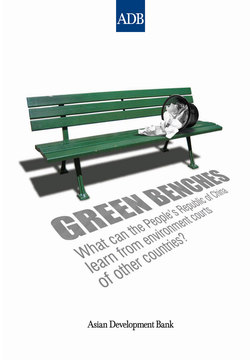Green Benches

Реклама. ООО «ЛитРес», ИНН: 7719571260.
Оглавление
Yi Chen. Green Benches
Contents
Abbreviations
Foreword
Report Summary
Introduction: What Are Environment Courts, and Why Are They Important?
The Environment Courts of the People’s Republic of China: Situations and Challenges. Environmental Disputes
Reasons to Develop Environment Courts
Experiences of Other Specialized Courts
Problems of Existing Environment Courts
Limited Access to Environment Courts
Insufficient Training of Most Judges in Environmental Law
Lack of Interest Among Victims of Environmental Pollution in Using the Courts to Protect their Rights
Refusal of Most Courts to Accept Environmental Cases
Inconsistencies in Environmental Case Judgments
Difficulties in Enforcing Court Orders in Environmental Cases
Weak Regulatory Support for Environmental Justice
Experiences of Other Countries in Strengthening Environment Courts
Improving Court Affordability
Encouraging Alternative Dispute Resolution
Training “Green” Judges
Improving Court Administrative Efficiency
Promoting Public Awareness and Participation
Monitoring and Evaluating Court Performance
The Way Forward: Policy Suggestions. Six Possible Modes of Environment Court Development in the People’s Republic of China
A Gradual Approach to Expanding the Environment Court System of the People’s Republic of China
Key Actions in Strengthening the Environment Courts of the People’s Republic of China
Conclusions
Appendix. The Current Judicial System in the People’s Republic of China
Отрывок из книги
Green Benches:
What can the People’s Republic of China Learn from Environment Courts of Other Countries?
.....
Since 1998, there has been an average yearly increase of 25% in the number of environmental lawsuits received by the people’s courts in the PRC. In 2005 alone, that number reached a record of nearly 700,000. There is still, however, a severe shortage of specialized environment courts relative to the number of environmental cases filed. In contrast to other specialized courts, environment courts make up only a small fraction of the 3,500 people’s courts and the more than 10,000 people’s tribunals. However, the total number of compensation cases arising from environmental pollution in 2003 alone reached 1,543, equivalent to one-half the yearly average of cases filed before the maritime courts in 20 years (1984–2004), or two-thirds the average of first-instance intellectual property rights cases filed nationwide each year.
There is thus a clear need for more specialized environment courts. In fact, the number of environmental cases is expected to rise as the PRC’s economy grows. If it continues to rise at the current rate of 25% per annum, the number of first-instance environmental cases will increase 2.4 times in 5 years and 7.4 times in 10 years. The situation is exacerbated by the fact that the percentage of environmental disputes that are brought to court is expected to increase, from the current rate of about 3% to about 10% within 5 years. The rapid upsurge in the number of environmental lawsuits, together with a decreasing number of judges in the PRC, makes the need for an expanded environment court system all the more urgent.
.....